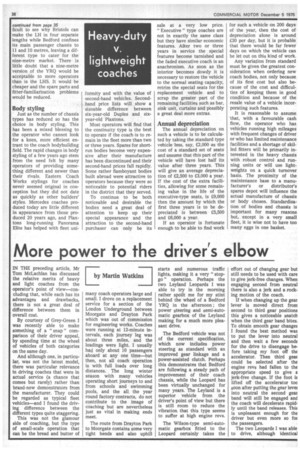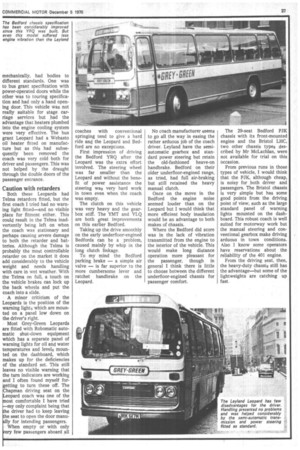More power to the driver's elbow
Page 38

Page 39

If you've noticed an error in this article please click here to report it so we can fix it.
by Martin Watkins IN THE preceding article, Mr Tom McLachlan has discussed the relative merits of heavy and light coaches from the operator's point of view—concluding that, while each has its advantages and drawbacks, there is not a great deal of difference between them in overall cost.
By courtesy of Grey-Green I was recently able to make something of a " snap " comparison of their driver appeal, by spending time at the wheel of vehicles of both categories on the same day.
And although one, in particular, was not the latest model, there was particular relevance in driving coaches that were in actual service (a chance that comes but rarely) rather than brand-new demonstrators from the manufacturer. They could be regarded as typical fleet vehicles—and I found the driving difference between the different types quite staggering.
This was not the glamour side of coaching, but the type of small-scale operation that can be the bread and butter of many coach operators large and small. I drove on a replacement service for a section of the London Underground between Moorgate and Drayton Park which was out of commission for engineering works. Coaches were running at 12-minute intervals, each journey leg was about three miles, and the loadings were light. I usually had only about 10 passengers aboard at any one time—but then, not all coach operation is with full loads over long distances. The long winter season with many vehicles operating short journeys to and from schools and swimming pools, and the all the year round factory contracts, do not contribute to the image of coaching but are nevertheless just as vital in making ends meet.
The route from Drayton Park to Moorgate contains some very tight bends and also uphill starts and numerous traffic lights, making it a very " stopgo " operation. Perhaps the two Leyland Leopards I was able to try in the morning rather spoilt me for my stint behind the wheel of a Bedford YRQ in the afternoon ; the power steering and semi-automatic gearbox of the Leyland making for a much more pleasant drive.
The Bedford vehicle was not of the current specification, which now includes power steering as standard with an improved gear linkage and a power-assisted clutch. Perhaps this demonstrates that Bedford are following a steady path of improvement of their coach chassis, while the Leopard has been virtually unchanged for many years. The Leyland is a superior vehicle from the driver's point of view but there is still room to reduce the vibration that this type seems to suffer at high engine revs.
The Wilson-type semi-automatic gearbox fitted to the Leopard certainly takes the effort out of changing gear but still needs to be used with care to give jerk-free changes. When engaging second from neutral there is also a jerk and a rocking motion of the coach.
If when changing up the gear lever is moved direct from second to third gear positions this gives a noticeable snatch when the third gear band bites. To obtain smooth gear changes I found the best method was to put the lever into neutral and then wait a few seconds for the drive to disengage before taking my foot off the accelerator. Then third gear could be selected after the engine revs had fallen to the appropriate speed to give a jerk-free change. If the foot is lifted off the accelerator too soon after putting the gear lever into neutral the second gem band will still be engaged and the coach will decelerate rapid. ly until the band releases. This is unpleasant enough for the driver but even more so for the passengers.
The two Leopards I was able to drive, although identical mechanically, had bodies to different standards. One was to bus grant specification with power-operated doors while the other was to touring specification and had only a hand opening door, This vehicle was not really suitable for stage carriage services but had the advantage that heaters plumbed into the engine cooling system were very effective. The bus grant Leopard had a Webasto oil heater fitted on manufacture but as this had subsequently been removed the coach was very cold both for driver and passengers. This was not helped by the draught through the double doors of the passenger entrance.
Caution with retarders
Both these Leopards had Telma retarders fitted, but the first coach I tried had no warning light fitted—and no visible place for fitment either. This could result in the Telma inadvertently being left on when the coach was stationary and perhaps causing severe damage to both the retarder and batteries. Although the Telma is probably the most controllable retarder on the market it does add considerably to the vehicle weight and needs handling with care in wet weather. With the Telma on full, a touch on the vehicle brakes can lock up the back wheels and put thecoach into a slide.
A minor criticism of the Leopards is the position of the warning lights which are mounted on a panel low down on the driver's right.
Most Grey-Green Leopards are fitted with Robomatic automatic shut-down equipment which has a separate panel of warning lights for oil and water temperatures and levels mounted on the dashboard, which makes up for the deficiencies of the standard set. This still leaves no visible warning that the turn indicators are working and I often found myself forgetting to turn these off. The Chapman driving seat on the Leopard coach was one of the most comfortable I have tried —my only complaint being that the driver had to keep leaving the seat to open the door manually for intending passengers.
When empty or with only very few passengers aboard all coaches with conventional springing tend to give a hard ride and the Leopard and Bedford are no exceptions.
First impression of driving the Bedford YRQ after the Leopard was the extra effort involved. The steering wheel was far smaller than the Leopard and without the benefit of power assistance the steering was very hard work in town even when the coach was empty.
The clutch on this vehicle was very heavy and the gearbox stiff. The YMT and YLQ are both great improvements on this earlier Bedford.
Taking up the drive smoothly on the early underfloor-engined Bedfords can be a problem, caused mainly by whip in the long clutch linkage.
To my mind the Bedford parking brake — a simple air valve — is far superior to the more cumbersome lever and ratchet handbrake on the Leopard. No coach manufacturer seems to go all the way in easing the rather arduous job of the coach driver. Leyland have the semiautomatic gearbox and standard power steering but retain the old-fashioned heave-on handbrake. Bedford on their older underfloor-engined range, as tried, had full air-braking but still retained the heavy manual clutch.
Once on the move in the Bedford the engine noise seemed louder than on the Leopard but I would think that more efficient body insulation would be an advantage to both makes of chassis.
Where the Bedford did score was in the lack of vibration transmitted from the engine to the interior of the vehicle. This would make long distance operation more pleasant for the passenger, though in general I think there is little to choose between the different underfloor-engined chassis for passenger comfort. The 29-seat Bedford PJK chassis with its front-mounted engine and the Bristol LHC, two other chassis types described by Mr McLachlan, were not available for trial on this occasion.
From previous runs in those types of vehicle, I would think that the PJK, although cheap, is noisy for ,both driver and passengers. The Bristol chassis is very simple but has some good points from the driving point of view, such as the large standard panel of warning lights mounted on the dashboard. This robust coach is well suited for motorway work but the manual steering and conventional gearbox make driving arduous in town conditions. Also I know some operators have reservations about the reliability of the 401 engine.
From the driving seat, then, the heavy-duty chassis still has the advantage—but some of the lightweights are catching up fast.


































































































































